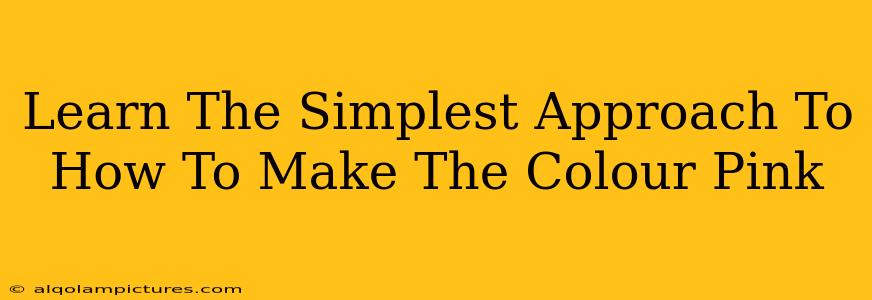Want to know how to make the color pink? It's easier than you think! This guide breaks down the simplest methods, perfect for artists, DIY enthusiasts, and anyone curious about color mixing. Let's dive in!
Understanding the Basics of Making Pink
Pink, a delicate and versatile hue, isn't a primary color. This means you can't find it straight from the tube; you need to mix it. The key ingredient? Red. The shade of pink you achieve depends on the type of red and the amount of white you add.
The Fundamental Pink Recipe
The simplest way to make pink is by mixing red and white. That's it! The ratio determines the intensity:
- Light Pink: More white, less red.
- Deep Pink/Rose: More red, less white.
- Bright Pink: A vibrant red with a touch of white.
Different Shades of Pink: Beyond Red and White
While red and white create a basic pink, experimenting opens up a world of possibilities. Here are some variations:
1. Using Different Reds
The type of red significantly impacts the final pink. Consider these options:
- Crimson Red: Yields a deep, rich pink with reddish undertones.
- Scarlet Red: Creates a bright, almost orange-toned pink.
- Rose Red: Results in a softer, more delicate pink.
Experiment! Mixing with different reds is a fun way to discover new shades.
2. Adding a Touch of Warmth with Orange
For a coral or peachy pink, add a tiny amount of orange to your red and white mixture. Start with a small amount and gradually increase until you achieve your desired hue.
3. Cooling it Down with Purple
A dash of purple can create unique pink shades with cool undertones. This is especially effective with warmer reds.
4. Exploring Other Color Combinations (Advanced)
For more complex pinks, you can explore other color combinations. However, these require a more experienced hand in color mixing.
Tips for Success
- Start small: Begin with small amounts of paint to avoid wasting materials.
- Mix gradually: Add color slowly, mixing thoroughly after each addition.
- Test on a palette: Always test your mixture on a separate palette before applying it to your final project.
- Use quality materials: Better-quality paints typically offer brighter, more vibrant colors.
SEO Optimization Strategies
This article aims to rank highly for relevant search terms. Here's how we've incorporated On-Page and Off-Page SEO strategies:
On-Page SEO:
- Keyword Optimization: The title, headings (H2, H3), and body text naturally incorporate keywords like "make pink," "color pink," "mix pink," "shades of pink," and variations thereof.
- Meta Description: (Not shown, but crucial!) A compelling meta description summarizing the article would be included for improved click-through rates.
- URL Structure: A clean and descriptive URL like
/how-to-make-pinkwould be used. - Image Optimization: Images (not included here, but essential) would be optimized with alt text using relevant keywords.
Off-Page SEO:
- Link Building: Promoting this article on relevant forums, social media platforms, and other websites would increase its visibility and authority.
- Guest Blogging: Contributing similar content to other blogs within the art, DIY, or color mixing niche can help increase backlinks.
By following these strategies and creating engaging, high-quality content, you can significantly boost your article's ranking in search engine results. Remember, consistency and quality content are key to long-term success in SEO.

